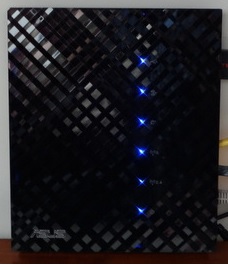Asus RT-N56U Dual-Band Wireless N Router Review
Pros
Cons
Rating

Introduction
The Asus RT-N56U Dual-Band Wireless N Router is a sleek and functional router with numerous features, the most obvious one being that it’s very slim, at just over two inches thick. Compared to routers from many other manufacturers, the N56U looks a generation ahead. It has six blue LED lights on the front to indicate activity, one WAN and four LAN ports on the side, plus two USB 2.0 ports for storage and printer connections.
Features
The N56U, despite its trim proportions, is loaded with features. Chief among these is its 802.11n dual-band functionality (2.4GHz and 5GHz), which, as you’ll see, puts it in another league compared to single-band 802.11n routers. It’s also backwards-compatible with 802.11a, 802.11b, and 802.11g. Additionally, it includes two USB 2.0 ports, as noted above, to allow for connection of printers and storage devices. Finally, its WAN and LAN ports operate on the Gigabit Ethernet, which in the case of wired connections or high speed wireless connections on the 5GHz band, actually does make a difference.
Unfortunately, the implementation of some of features above, chiefly the USB 2.0 connectivity, leaves a lot to be desired. Upon attaching a USB 3.0 hard drive to the USB port, the firmware crashed. Only after switching to a USB 2.0 hard drive were we able to use external storage reliably. Eventually we just switched to a flash drive, since speeds were so slow (see below for details). Furthermore, Windows isn’t able to reliably connect to the storage device at boot up, and sometimes drops the connection at random.
Worse yet, we found the USB 2.0 printer functionality to be entirely unworkable. While a printer could be set up using the included Asus printer utility, the connection to the printer would be lost quite frequently, requiring a router reboot to reconnect, and furthermore, when printing large documents such as PDFs, graphical would occur, as if the router wasn’t able to pass all of the data to the printer, resulting in digital streaks across our documents. In the end, after repeated attempts to use the feature reliably, we called it quits, instead connecting a network-ready printer via Ethernet. It’s worked fine ever since, so at least the router doesn’t interfere with built-in networking provided by such printer models.
One other minor quibble – the detachable base of the N56U has a bad habit of detaching itself, and even when it’s solidly on, it has a hard time keeping the lightweight router upright when multiple Ethernet cables are sticking out the side of the router. Furthermore, the elegant design of the router quickly becomes a bit of an eyesore with these cables attached. Despite its looks, you’ll probably be best off propping this router up against a wall and behind your other components, so as to keep it from tipping over and to hide the cables away.

Performance
If its extra features are this router’s weak point, its core function, wireless routing, is nearly without peers. Starting with 802.11n speeds on the 2.4GHz band, we were able to achieve data transfer speeds between networked computers of over 4 MB/s (32 Mbps), through two walls. This result is good, but in an era of 25mbps cable or faster Internet connections, it’s coming close to being a bottleneck for data-intensive Internet use, such as streaming video. So we switched over to the 5GHz band for some throughput tests, and we found that the N56U performed admirably – we achieved consistent transfer speeds of 10.5 MB/s (84 Mbps), again through two walls. That’s over two and a half times faster than the 2.4GHz connection! As a final test, we set up our 802.11ac bridge, which uses a newer protocol than the N56U, but even operating on the older 802.11n 5GHz band, we achieved a constant 16 MB/s (128 Mbps), which should be fast enough to support just about every Internet service out there. That’s probably about the peak performance you’ll see from this router, but even using an 802.11n adapter, we can certainly say the Asus RT-56U has the wireless networking chops to suit nearly any home or small office user.
Alas, despite the fast speeds offered by the router, its USB 2.0 data storage speed is painfully slow. We’ve seen maximum read and write speeds of about 12Mbps, far slower than the router is capable of passing data. That’s on a wired connection. When connecting via wireless through a notebook computer, the data rates are painfully slow, often dropping to under 1Mbps.
Conclusion
For the price, you simply will not find the features offered by Asus RT-N56U on any other router. Dual-band, high-power, dual USB ports for storage and printer sharing, a stylish design, and excellent support (yes, we did contact Asus to see if we could get that printer working…). Which of course brings us back to its drawbacks – its USB 2.0 functionality is seriously unreliable.
In the end, we can’t give the N56U a perfect score, but for its core purpose, wireless routing, it’s simply fantastic. If you decide to go with the N56U, do yourself a favor and pick up a dual-band adapter to make sure you’re getting the most out of its capabilities.
The Asus RT-N56U Wireless Dual-Band Router is available for $99.99 with free shipping from Amazon, at of our publication date.

